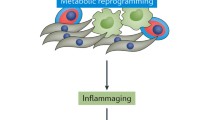Abstract
It is now generally accepted that the extracellular matrix of human articular cartilage is in a state of dynamic equilibrium. The synthesis of both proteoglycan and collagen by the chondrocytes and the natural turnover of these molecules by enzymes released from these cells maintains a balance which is essential for the structural integration and function of the extracellular macromolecules. Under pathological conditions this balance may be disturbed by changes in the anabolic or catabolic activity of the indigenous chondrocytes or by the actions of surrounding connective tissues [1]. Thus, in rheumatoid arthritis (RA), where pannus erosion of cartilage is one of the prime causes of articular damage, it is lik:ely that the extrinsic proteases, and in particular, metalloproteinases, of the synovial fibroblasts and inflammatory cells are responsible for much of the erosive process. This effect is probably compounded by the action of cytokines on the cartilage chondrocytes inhibiting proteoglycan (GAG) synthesis and hence diminishing repair processes. This effect of cytokines in inhibiting synthesis is now well documented but has still not received the attention that it probably warrants. Studies by Dingle et al. [2] have demonstrated that human cartilage is extremely sensitive to inhibition of GAG synthesis — <0.01 ng ml-1 h-1 IL1a will give >50% inhibition of chondrocytic matrix synthesis in normal, osteoarthritic (OA) and RA cartilage, the most severe effects being seen in those tissues with high metabolic activity.
Access this chapter
Tax calculation will be finalised at checkout
Purchases are for personal use only
Preview
Unable to display preview. Download preview PDF.
Similar content being viewed by others
References
Dingle J.T. Cartilage damage and repair: the roles of IL-1, NSAIDs and prostaglandins in osteoarthritis. In: New Frontiers in Prostaglandin Therapeutics. Princetown, USA: Excerpta Medica: 1991.
Dingle J.T., Homer A., Shield M. The sensitivity of synthesis of human cartilage matrix to inhibition by IL1 suggests a mechanism for the development of osteoarthritis. Cell Biochem Funct. 1991;9:99–102.
Martin M., Resch K. Interleukin 1: More than a mediator between leucocytes. TIPS. 1988;9:171–177.
Brandt K.D. Effects of non-steroidal anti-inflammatory drugs on chondrocyte metabolism in vitro and in vivo. Am J Med. 1987;83(Suppl. 5A);29–34.
Hess E.V., Herman J.H. Cartilage metabolism and anti-inflammatory drugs in osteoarthritis. Am J Med. 1986;77(Suppl. 5B):36–43.
Kalbhen D.A. The influence of NSAIDs on morphology of articular cartilage. Scand J Rheumatol. 1989;77(Suppl.);13–22.
Page-Thomas D.P., King B., Stephens T., Dingle J.T. In vivo studies of cartilage regeneration after damage induced by catabolin/IL1. Ann Rheum Dis. 1987;46:527–533.
Perry G.H., Smith M.J.G., Whiteside C.G. Spontaneous recovery of the joint space in degenerative hip disease. Ann Rheum Dis. 1972;31:440–448.
Danielsson L.G. Instance and prognosis of coxarthrosis. Acta Orthop Scand. 1964;66(Suppl.): 1–114.
Dieppe P. Osteoarthritis. The scale and scope of the clinical problem. In: Dieppe P. ed. Osteoarthritis: Current Research and Prospects for Pharmacological Intervention. London: IPC Technical Services;1988:40–66.
Kunkel S.L., Chensue S.W. Arachidonic acid metabolites regulate interleukin 1 production. Biochem Biophys Res Commun. 1985;128:892–897.
Rashed S., Revell P., Hemingway A. et al. Effect of non-steroid anti-inflammatory drugs on the course of osteoarthritis. Lancet. 1989;2:519–522.
Author information
Authors and Affiliations
Editor information
Editors and Affiliations
Rights and permissions
Copyright information
© 1992 Springer Science+Business Media Dordrecht
About this chapter
Cite this chapter
Dingle, J.T. (1992). NSAIDs and human cartilage metabolism. In: Rainsford, K.D., Velo, G.P. (eds) Side-Effects of Anti-Inflammatory Drugs 3. Inflammation and Drug Therapy Series, vol 5. Springer, Dordrecht. https://doi.org/10.1007/978-94-011-2982-4_31
Download citation
DOI: https://doi.org/10.1007/978-94-011-2982-4_31
Publisher Name: Springer, Dordrecht
Print ISBN: 978-94-010-5325-9
Online ISBN: 978-94-011-2982-4
eBook Packages: Springer Book Archive




